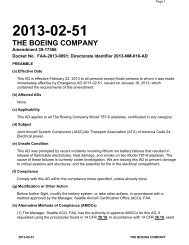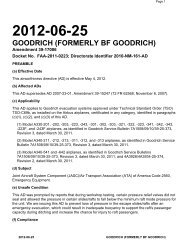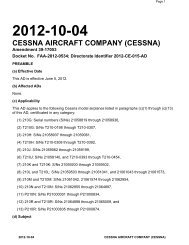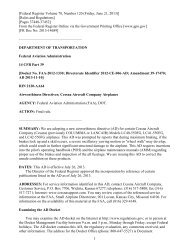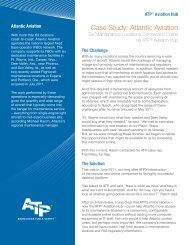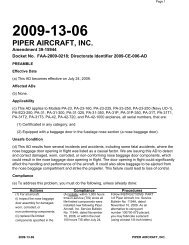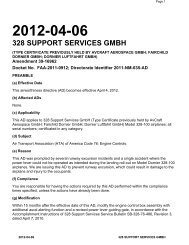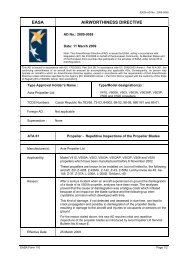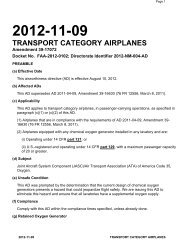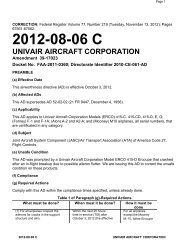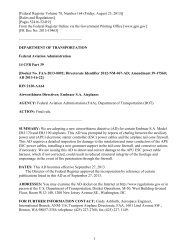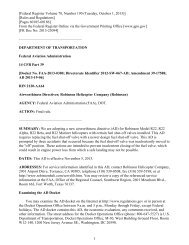AD 2013-06-51 - Civil Aviation Safety Authority
AD 2013-06-51 - Civil Aviation Safety Authority
AD 2013-06-51 - Civil Aviation Safety Authority
Create successful ePaper yourself
Turn your PDF publications into a flip-book with our unique Google optimized e-Paper software.
Differences Between This <strong>AD</strong> and the EASA <strong>AD</strong>The EASA <strong>AD</strong> applies to specific model helicopters. This <strong>AD</strong> applies to all helicopters withcertain Goodrich hoists installed that are type certificated in the U.S. This <strong>AD</strong> does not contain arequirement to report results to the manufacturer. The EASA <strong>AD</strong> requires complying with specifichelicopter manufacturer ASBs, and this <strong>AD</strong> requires complying with the Goodrich ASB forconducting the load inspection test.Interim ActionWe consider this <strong>AD</strong> to be an interim action. Investigation of the root cause of the clutch failureis ongoing. If final action is later identified, we might consider further rulemaking.Costs of ComplianceWe estimate that this <strong>AD</strong> will affect 1,378 helicopters of U.S. Registry. We estimate thatoperators may incur the following costs in order to comply with this <strong>AD</strong>. It will take about 1 workhourto perform the lift testing at an average labor rate of $85 per work-hour, for a cost per helicopterof $85 and a total cost to U.S. operators of $117,130. If necessary, replacing the hoist will take about0.5 work-hour and required parts will cost about $95,000, for a cost per helicopter of about $95,043.FAA's Justification and Determination of the Effective DateThe short compliance time involved is required because risk analysis of the previously describedunsafe condition indicates that failure of the hoist could result in serious injury or death if the hoist isbeing used for human cargo. Subsequently, the required actions must be performed before the nextflight involving a hoist operation.Since it was found that immediate corrective action was required, notice and opportunity forprior public comment before issuing this <strong>AD</strong> were impracticable and contrary to the public interestand good cause existed for making Emergency <strong>AD</strong> No. <strong>2013</strong>-<strong>06</strong>-<strong>51</strong> effective immediately on March25, <strong>2013</strong>, to all known U.S. owners and operators of the specified model helicopters. Theseconditions still exist and the <strong>AD</strong> is hereby published, with a minor change, in the Federal Register asan amendment to section 39.13 of the Federal <strong>Aviation</strong> Regulations (14 CFR 39.13) to make iteffective to all persons.<strong>Authority</strong> for This RulemakingTitle 49 of the United States Code specifies the FAA's authority to issue rules on aviation safety.Subtitle I, section 1<strong>06</strong>, describes the authority of the FAA Administrator. ''Subtitle VII: <strong>Aviation</strong>Programs,'' describes in more detail the scope of the Agency's authority.We are issuing this rulemaking under the authority described in ''Subtitle VII, Part A, Subpart III,Section 44701: General requirements.'' Under that section, Congress charges the FAA with promotingsafe flight of civil aircraft in air commerce by prescribing regulations for practices, methods, andprocedures the Administrator finds necessary for safety in air commerce. This regulation is within thescope of that authority because it addresses an unsafe condition that is likely to exist or develop onproducts identified in this rulemaking action.Regulatory FindingsWe determined that this <strong>AD</strong> will not have federalism implications under Executive Order 13132.This <strong>AD</strong> will not have a substantial direct effect on the States, on the relationship between the4



